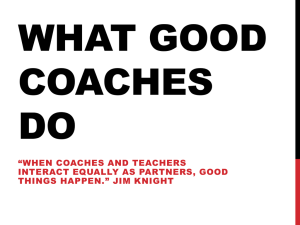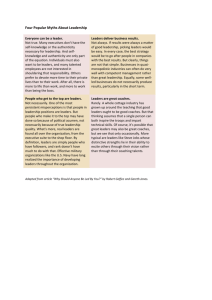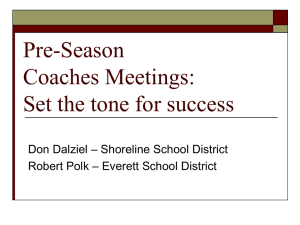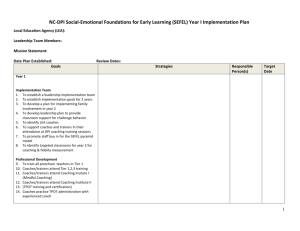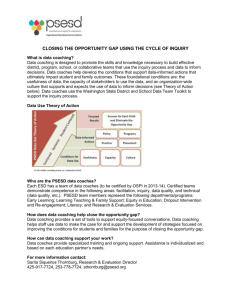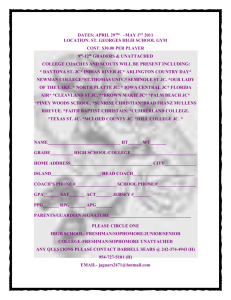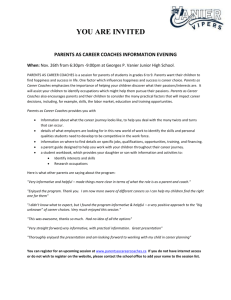What Good Coaches Do - iu14coaches
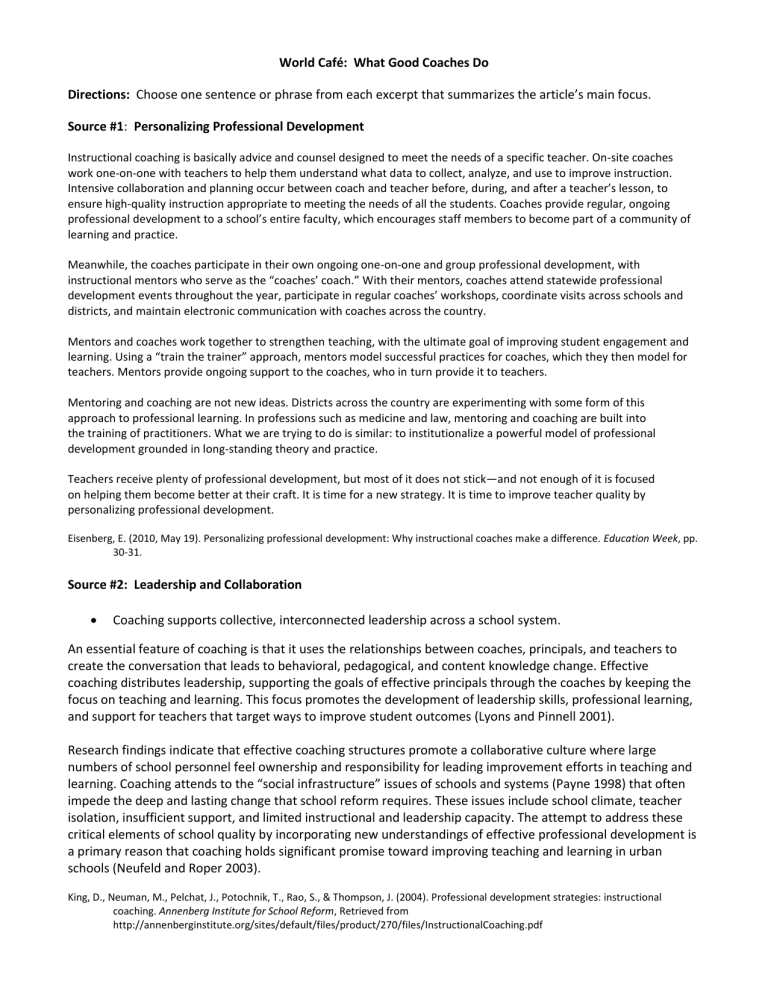
World Café: What Good Coaches Do
Directions: Choose one sentence or phrase from each excerpt that summarizes the article’s main focus.
Source #1: Personalizing Professional Development
Instructional coaching is basically advice and counsel designed to meet the needs of a specific teacher. On-site coaches work one-on-one with teachers to help them understand what data to collect, analyze, and use to improve instruction.
Intensive collaboration and planning occur between coach and teacher before, during, and after a teacher’s lesson, to ensure high-quality instruction appropriate to meeting the needs of all the students. Coaches provide regular, ongoing professional development to a school’s entire faculty, which encourages staff members to become part of a community of learning and practice.
Meanwhile, the coaches participate in their own ongoing one-on-one and group professional development, with instructional mentors who serve as the “coaches’ coach.” With their mentors, coaches attend statewide professional development events throughout the year, participate in regular coaches’ workshops, coordinate visits across schools and districts, and maintain electronic communication with coaches across the country.
Mentors and coaches work together to strengthen teaching, with the ultimate goal of improving student engagement and learning. Using a “train the trainer” approach, mentors model successful practices for coaches, which they then model for teachers. Mentors provide ongoing support to the coaches, who in turn provide it to teachers.
Mentoring and coaching are not new ideas. Districts across the country are experimenting with some form of this approach to professional learning. In professions such as medicine and law, mentoring and coaching are built into the training of practitioners. What we are trying to do is similar: to institutionalize a powerful model of professional development grounded in long-standing theory and practice.
Teachers receive plenty of professional development, but most of it does not stick—and not enough of it is focused on helping them become better at their craft. It is time for a new strategy. It is time to improve teacher quality by personalizing professional development.
Eisenberg, E. (2010, May 19). Personalizing professional development: Why instructional coaches make a difference. Education Week, pp.
30-31.
Source #2: Leadership and Collaboration
Coaching supports collective, interconnected leadership across a school system.
An essential feature of coaching is that it uses the relationships between coaches, principals, and teachers to create the conversation that leads to behavioral, pedagogical, and content knowledge change. Effective coaching distributes leadership, supporting the goals of effective principals through the coaches by keeping the focus on teaching and learning. This focus promotes the development of leadership skills, professional learning, and support for teachers that target ways to improve student outcomes (Lyons and Pinnell 2001).
Research findings indicate that effective coaching structures promote a collaborative culture where large numbers of school personnel feel ownership and responsibility for leading improvement efforts in teaching and learning. Coaching attends to the “social infrastructure” issues of schools and systems (Payne 1998) that often impede the deep and lasting change that school reform requires. These issues include school climate, teacher isolation, insufficient support, and limited instructional and leadership capacity. The attempt to address these critical elements of school quality by incorporating new understandings of effective professional development is a primary reason that coaching holds significant promise toward improving teaching and learning in urban schools (Neufeld and Roper 2003).
King, D., Neuman, M., Pelchat, J., Potochnik, T., Rao, S., & Thompson, J. (2004). Professional development strategies: instructional coaching. Annenberg Institute for School Reform, Retrieved from http://annenberginstitute.org/sites/default/files/product/270/files/InstructionalCoaching.pdf
Source #3: Partnership
Coaches who act on the partnership principles engage in the following practices.
They Identify Teachers' Goals
Coaches who take a top-down approach to coaching arrive in classrooms with a predetermined collection of strategies and see it as their job to convince the teacher to use them.
However, when coaches take the partnership approach, their efforts are guided by specific goals that teachers hold for their students. Partnership coaches start by gathering data with or for the teacher. They then collaborate with the teacher to identify a specific student goal. Student goals can be either academic (for example, 95 percent of students will demonstrate mastery of this concept on the next test); behavioral
(students will be on task more than 90 percent of the time); or attitudinal (90 percent of students will ask to read a book for pleasure over the break).
They Listen
Ensuring that others know we hear them and that we want to know their ideas communicates that we see them as partners. We can't be partners unless we understand how our partners see things.
During partnership coaching conversations, coaches create a setting in which collaborating teachers feel comfortable saying what they think. Coaches are curious to understand, and they make sure the conversation focuses on the teachers' concerns. In this way, they get to hear the real truth.
They Ask Questions
Coaches ask questions of their partners because they're more concerned with getting things right than with being right. Therefore, they ask good questions to which they don't know the answers—and they listen for the answers. For example, when they ask, "What evidence did you see that shows that your students are learning?" they want to know what the teacher thinks, not guide the teacher to see what they see. They stop persuading, and they start learning.
They Explain Teaching Practices
When coaches explain practices, they should be precise and provisional. As Atul Gawande pointed out in The
Checklist Manifesto (2010), precision is an essential part of coaching. If we can't explain a practice clearly, we can't expect teachers to implement it effectively.
However, precision that doesn't account for an individual's thoughts and knowledge runs the risk of alienating teachers. Partnership coaches not only give precise explanations, but also ask teachers how they can adapt practices to best fit their teaching style and meet their students' needs. Thus, a coach might share a checklist describing how to model metacognitive reading strategies, with a step-by-step explanation of the process.
However, while explaining it, the coach would ask the teacher whether that process would work for her students or for her teaching style.
The reality is that teachers will adapt practices to make them their own. By taking the partnership approach, coaches can collaborate with teachers on creating the best fit. To think that each practice must be done in exactly the same way in every classroom underestimates the complexity of the process. In education, as Eric Liu
(2004) has explained, "It's never one size fits all; it's one size fits one."
They Provide Feedback
The term feedback often brings to mind traditional top-down feedback. We envision a coach who gives an athlete feedback on how to hit the ball or jump a hurdle. This kind of feedback usually involves giving some positive comments, explaining how to improve, and ensuring that the listener knows what he or she needs to do to improve.
When coaches take the top-down approach in school, they use data to explain what they think the teacher has done well and what she or he needs to do to improve. Top-down coaches do most of the talking because they want to make sure that teachers learn how to do something correctly. However, the problem with top-down feedback is that it's based on the assumption that there's only one right way to see things—and that right way is always the coach's way.
An alternative to top-down feedback is the partnership approach—the collaborative exploration of data. Here, coach and teacher sit side by side as partners and discuss their interpretations of the data that the coach has gathered. Coaches don't withhold their opinions, but they offer them provisionally, communicating their openness to the teacher's point of view.
Knight, J. (2011). What good coaches do. Educational Leadership , 69 (2), 18-22.
Source 4: Steve Barkley Types of Coaching Part 1 (YouTube) http://www.youtube.com/watch?v=ZHFkPn4GtsU (link also posted http://iu14coaches.wikispaces.com/Meetings )
My Viewing Notes Implications for My Practice
